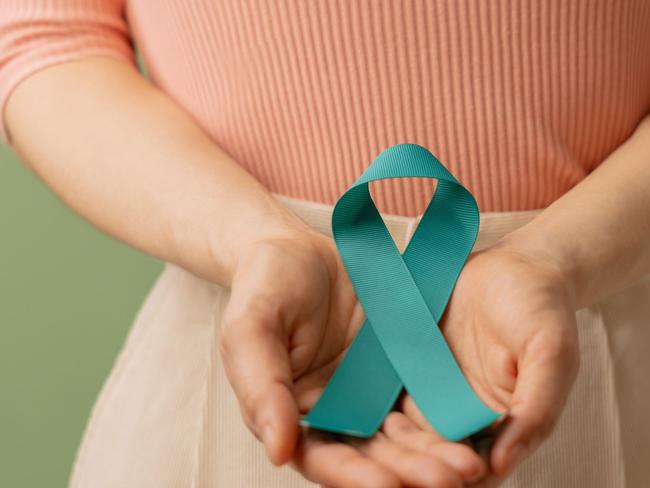Endometriosis and ovarian cancer face lack of funding and treatment options
Aliza Lynch waited a decade to finally find out she had endometriosis. It was a huge relief after years of vomiting and fainting and being dismissed.
Endometriosis
Don't miss out on the headlines from Endometriosis. Followed categories will be added to My News.
It took almost a decade for Aliza Lynch to confirm she had endometriosis despite living with crippling pain that was so bad she would faint and vomit for a week every month.
The 24-year-old, who is now doing a masters in microbiology, first started struggling at the age of 13 when she got her first period.
“For a week every single month in high school, I would get really, really sick so that’s a huge portion taken out of school,” said Ms Lynch, who lives in Doreen.
But every time she went to the doctors she says she was told it was hormones and she would grow out of it.
“It was brushed off,” she said.
From the age of 14 she was put on the pill, which helped with the fainting, extreme pain and throwing up.
But being on the oral contraception called Estelle badly affected her mental health, making her feel very unstable.

Then, when she was in her first year of uni she attempted suicide.
Royal Australian College of General Practitioners (RACGP) Associate Professor Magdalena Simonis said that it was important doctors checked someone’s history before prescribing oral contraceptives.
“If they have a history of depression, mental health issues or Premenstrual Dysphoric Disorder then they might be really sensitive to the progesterone in the pill,” she said, adding it was not common and many women took the pill safely without complications.
Ms Lynch went off the pill which helped, but a year later the debilitating pain returned in what she described as an “endo attack”.
“I was on all fours in my bathroom, moaning, crying, it was such incredible pain,” she said.
She went to the hospital where they did ultrasounds to check if it was appendicitis before being sent home.
She went back to the hospital multiple times due to unbearable pain before one trainee doctor suggested she may have endometriosis.
Ms Lynch booked in for an internal ultrasound but nothing showed up, before then finding a specialist who suggested keyhole surgery which confirmed she had stage-three endometriosis.
“It helped to know what it was finally,” she said.
Since then she has been doing better and has started taking a different oral contraceptive which has helped with the symptoms.
Mental health resources are available online via Beyond Blue at www.beyondblue.org.au or people can call a counsellor on 1300 22 4636
The Silent Crisis: The overlooked battle for funding and treatment in ovarian cancer and endometriosis
By Professor Alan Trounson AO
Women’s health has suffered long-term disappointments in targeted research and the key funding that needs to be committed to making progress at the level we should expect.
Ovarian cancer and endometriosis are two critical women’s health issues with devastating effects and neither has attracted the attention of significant resources to make acceptable progress in therapeutic options.
Despite their widespread impact, both conditions face a significant lack of funding, research, and treatment options.
Why this is the case, is difficult to answer.
Ovarian cancer is a group of complex and rare cancers with one of the lowest survival rates in Australia It is generally diagnosed at an advanced stage because women accept pelvic pain as a normal situation, early diagnostic tests are unavailable and as a consequence regular screening for ovarian cancer doesn’t happen.
Ovarian cancer is considered a “cold cancer” because of the dispersed tumours in the pelvic cavity and reduced blood supply to these tumours.
This has made it more difficult to target with small molecules and immunotherapies.
Being difficult is not a reason to not focus on this cancer; the lack of effective therapy should be a strong driver.

Notably despite progress broadly in understanding and treating cancer, the present five-year survival rate for ovarian cancer is lower than the five-year average survival rate observed for all cancers in 1975.
Endometriosis occurs in one in seven females and those assigned female at birth, or 14 per cent of girls and women in Australia are now estimated to live with endometriosis, up from one in ning and 11 per cent.
It is a condition that has happened because of frequent menstruation.
In evolution, there wasn’t selection against this happening because menstruation was a rarity as women were either pregnant or lactating, most of their fertile life.
Endometriosis occurs when uterine endometrial cells back-flow into the pelvic cavity and grows ectopically without the possibility of being shed from the body, as in menstruation. Endometrial tissue can also grow in the uterine muscle layer and is known as adenomyosis. Both conditions are associated with pain and infertility.
Aside from surgery and heavy steroid therapy, there are no treatments available.
Endometriosis is also associated with an increased incidence of cancer and is possibly related to the elevated mutational burden noted in endometrial tissue, ranging from 209 to 2833 base substitutions per woman, many in oncogenes.
Endometriosis should be controlled where possible.
Economic and healthcare costs associated with endometriosis have not adequately addressed, it affects a significant portion of women and yet remains severely underfunded.
Despite available information on the outcomes of diagnosing ovarian cancer, there are many obstacles for developing effective therapies.
Ovarian cancer remains one of the leading causes of cancer-related deaths in women in Australia, is the most lethal of the gynaecological malignancies and predicted to increase by 42 per cent and deaths increase by 55 per cent by 2040.
The ugly reality is that 80 per cent of patients present for diagnosis are in either stage III or stage IV, and their five-year survival rate is 27 per cent and 13 per cent, respectively.
This is not acceptable.
Ovarian cancer research is underfunded, the patients have very limited access to precision medicine, recurrence rates are 70-80 pre cent and there are very few targeted therapies. Patients can be often misdiagnosed because of gender bias misattribution of symptoms.
The consequences of later diagnosis are prolonged suffering and poor outcomes.
Endometriosis is extraordinarily widespread, affecting 5-15 per cent of reproductive age women worldwide.
The prevalence is 31 pre cent of women with infertility and 42 per cent among women with chronic pelvic pain. In Australia alone, endometriosis costs $21-$23m in healthcare costs and lost productivity every day.
Again, women face significant delays in diagnosis, with symptoms misattributed to other causes leading to worse symptoms, complications and increased risk of cancer.
The high association with infertility increases the stress among women and the need for treatments such as IVF.

The presence of endometriosis may interfere with ovulation, cause painful adhesions and lead to endometrioma (cysts) that can be painful and disruptive of infertility.
Adenomyoma is not easily treated and can be associated with pain, excessive bleeding, infertility and lifestyle disruption. Despite the high prevalence and economic costs, funding for endometriosis research is minimal compared to other health conditions.
Treatments include conservative surgery, pain medicine, hormone therapy such as contraceptives, gonadotrophin releasing hormone agonists and antagonists (lowers
oestrogen levels), progestin therapy (blocks ovulation and menstruation) and aromatase inhibitors (lower oestrogen).
None of these will eradicate endometriosis and many have unacceptable side-effects.
The situation and genuine treatment options are desperately needed to control endometriosis.
Significant investment is needed in research and therapeutic options for these underfunded conditions that are significantly affecting the lives of women.
There is some interest in chimeric antigen receptor (CAR) driven immunotherapies, but the demanding development and regulatory costs are resulting in therapies similar to those treating blood cancers to be prematurely tried instead of addressing the more complex solid tumour microenvironment that inhibits therapies and the host’s own immune capacity to deal with cancer.

Companies like Cartherics are developing complex therapies that can effectively target solid tumours such as ovarian cancer.
It seems that similar products may also control endometriosis or even adenomyosis.
It is possible that these products can be inhaled, and that continued development may enable patients to have access to such products themselves for the ongoing control of conditions such as endometriosis.
It is a matter of good research, time, investment and determination to deliver these outcomes for patients.
This is all necessary and should include academia, medical research institutes, companies, government and the community.
Alignment of effort is critical and must be achieved.
We must improve survival rates and quality of life with the necessary focus on outcomes. Simply encouraging only one or other of these necessary components will doom the pipeline to failure.
We support early detection of these serious conditions, we need to address the gender bias that exists, prioritise women’s health and wellbeing and improve the economic participation of women in the workforce and reduce the healthcare costs for these treatments in the long term.
The government has a pivotal role in changing this priority in favour of women’s health and it should create more opportunity to engage industry, academia and medical research institutes with the patient advocate community to ensure this happens.
Australia has the capacity to lead the world as it did in human IVF but there needs to be clear direction and resources for this to happen.
Professor Alan Trounson is a Distinguished Scientist, Hudson Institute of Medical Research.
More Coverage
Originally published as Endometriosis and ovarian cancer face lack of funding and treatment options





